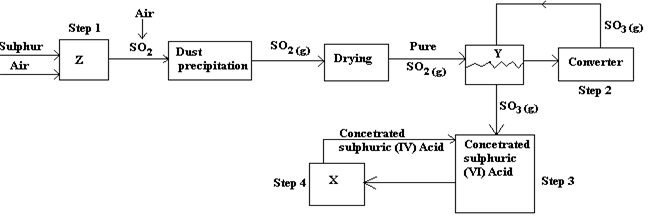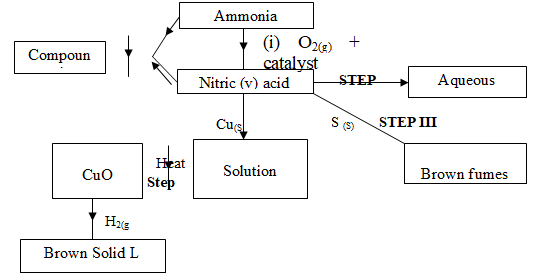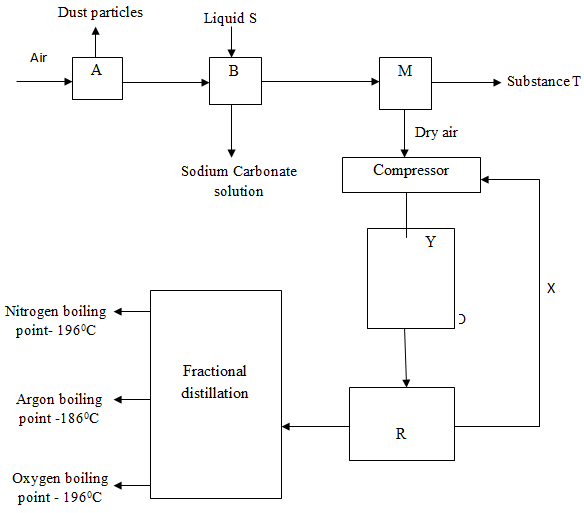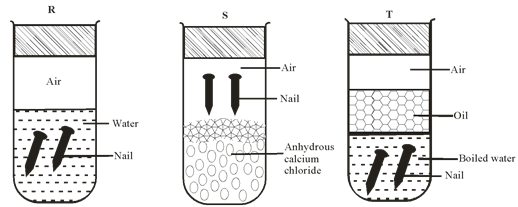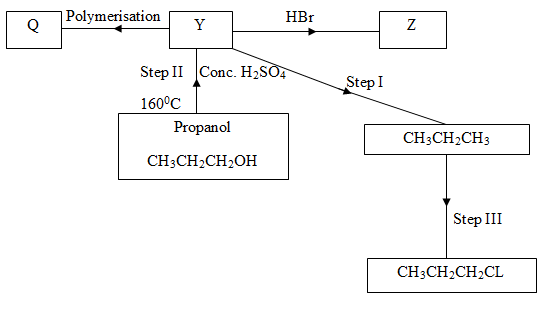INSTRUCTIONS TO CANDIDATES
- Answer ALL the questions in the spaces provided.
- Mathematical tables and silent electronic calculators may be used.
- All working MUST be clearly shown where necessary.
- The grid below shows part of the periodic table. Study it and answer the questions that follow. The letters do not represent the true symbols of the elements.
- Which element forms an ion of charge - 2? Explain your answer 2marks
- What is the nature of the oxide formed by element C? 1mark
- How does the reactivity of H compare with that of E? Explain. 2marks
- Write the chemical equation for the reaction between B and chlorine? 1mark
- Explain how the atomic radii of the following compare; 2marks
- F and G
- B and G
- The oxides of B and D are separately dissolved in water. State the effect of each product on litmus paper. 2marks
- 20cm3 of a solution of a hydroxide of I completely neutralizes 17.5cm3 of 0.5M sulphuric (VI) acid. Calculate the concentration in moles/litre of solution of the hydroxide of I 3marks
- The diagram below shows an experiment set-up to investigate a property of carbon (ii) oxide. Study it and answer the questions that follow.
- Name one condition that is missing in the set up that must be present if the experiment to proceed. 1mark
- If the experiment was carried out properly. What observation would be made in the combustion tube? 1mark
- Give an equation for the reaction that occurs in the combustion tube. 1 ½ mark
- Give an equation for the reaction that takes place as gas x burns. 1 ½ marks
- Why is it necessary to burn gas x? 1mk
- Name the reducing and oxidizing agent. 2marks
- Reducing agent
- Oxidising agent
- Identify any other substance that would have the same effect on copper (ii) oxide as carbon (ii) oxide. 1mark
- What would happen if copper (ii) oxide was replaced with sodium oxide? Explain 2mark
-
- Sulphur occurs naturally in two different forms called allotropes;
- What are allotropes? 1mark
- The two allotropes of sulphur are stable at different temperatures, as shown in the equation below.
Above 95.5°C
Rhombic sulphurMonoclinic sulphur
Below 95.5°C
Give a name to the temperature 95.5°C 1mark
- Below is a flow chart diagram for the contact process for the manufacture of sulphuric (VI) acid.
- Give the name of chambers labeled 1 ½ mark
X
Y
Z - State the three conditions in the converter. 1 ½ mark
- Explain why gases are passed through ; 2marks
I – The dust precipitator and drying power
II- The chamber labeled Y - Write the balanced equations for the reactions in; 3marks
Step 2:
Step 3:
Step 4:
- Give the name of chambers labeled 1 ½ mark
- Calculate the volume of sulphur (VI) oxide gas in litres that would be required to produce 178kg of Oleum in step 3. (Molar gas volume at s.t.p.=22.4l, H=1, O=16, S=32) 3marks
- Sulphur occurs naturally in two different forms called allotropes;
- The scheme below shows various reactions starting with ammonia. Study it and answer the questions that follow.
- List the raw materials used in the manufacturer of ammonia gas. 1mark
- What catalyst is used in step I? 1mark
- Write an equation for the reaction that occurs between ammonia and oxygen gas in the presence of a catalyst. 1mark
- Identify the process is step II? 1mark
- Using an appropriate equation, explain how the reaction in step III occurs (1 mark)
- What should be added to solution K to form solid L? (1 mark)
-
- Write the formula of compound J.
- Calculate the mass of compound J that would contain 14g of nitrogen. (N=14, O=16, H= 1) (2marks)
- Explain the advantage of using ammonium phosphate fertilizer over the other nitrogenous fertilizers. (1mark)
- Dry chlorine was collected using the set up below.
- Name a suitable drying agent for chlorine gas? 1mark
- State one property of chlorine gas which facilitates this method of collection. 1mark
- State the observations on the moist blue litmus paper. 2marks
- Chlorine gas was bubbled through distilled water. With aid of an equation show the formation of chlorine water. 1mark
- Write the formula of the compounds formed when chlorine gas reacts with warm dry phosphorous. 2marks
- Chlorine gas is mixed with moist hydrogen sulphide gas, state and explain the observations 2marks
- Give one use of chlorine gas. 1mark
- Fractional distillation of air is used in the industrial manufacture of oxygen. The diagram below shows the process.
- What processes are taking place in chamber A,B,M and D 2marks
- Name;
- Liquid S
- Substance T
- Explain why part Y in chamber D is curved? 1mark
- Give two industrial uses of oxygen gas? 2marks
- In the laboratory preparation of oxygen, manganese (iv) oxide and hydrogen peroxide are used. Write an equation to show how oxygen gas is formed. 1mark
- An investigation was carried out using the set-up below. Study it and answer the questions that follow.
- State and explain what will happen in the three test-tubes R, S and T after seven days. 3marks
- Give one reason why some metals are electroplated. 1mark
- Below is a scheme of some reactions of propanol. Study it and answer the questions that follow.
- State the reagents and conditions required to effect step I 3marks
- Draw the structural formulae and name product Z. 1mark
- Name product Q 1mark
- Explain how product Y can be distinguished from the product formed after step I has taken place. 2marks
- What name is given to the process in Step II and step III 2marks
-
- Define the term hydrocarbon 1mark
- Draw the structure of 1, 2 – dibromopropane 1mark

MARKING SCHEME
Question one
- A (√1mk) elements in group (vi) have 6 electrons in the outermost energy level, they react by gaining 2 electrons.√1m
- Amphoteric Oxide √1mk
- Element E is more reactive than H (√1mk) Elements E and H are non - metals in group (VII) and reactivity decreases down the group √1mk / E is smaller than H and hence has a higher electron affinity therefore more reactive.
- B(s) + Cl2(g) BCl2(s) 1mk
-
- The atomic radius of element F is greater than that of G √1mk / Across period number of protons (nuclear charge increases increasing effective nuclear charge.
- The atomic radius of element G is greater than that of B. √1mk
- Solution of oxide of B changes red litmus paper blue and has no effect on blue litmus paper 1mk while solution of oxide of D changes blue litmus paper red and has no effect on red litmus paper. 1mk
- 2IOH (aq) + H2SO4 (aq) → I2SO4(aq) + 2H2O(l) √1mk
2 : 1
Moles of H2SO4 → 17.5 x0.5 = 0.00875moles √½ mk
1000
Moles of IOH 0.00875 ÷ 2 = 0.004375 moles √½ mk
Molarity of IOH = 1,000 x 0.004375
20
= 0.21875M √1mk
Concentration = 0.21875 moles/litre √½ mk
Question Two
- Heating copper (ii) oxide √1mk
- Black solid would turn brown √1mk
- CuO(s) + CO(g) → Cu(s) + CO2(g) √1 ½ mk
- 2CO(g) + O2(g) 2CO2(g) √1 ½ mk
- It is poisonous √1mk
-
- Reducing agent - Carbon(ii) oxide √1mk
- Oxidisingagent -Copper (ii) oxide √1mk
- Hydrogen / ammonia gas (Any one) √1mk
- There would be no observable change √1mk. This is because sodium is higher than carbon in the reactivity series and therefore has higher affinity of oxygen √1mk
Question three
-
- Crystalline forms of sulphur √1mk
Or
Existence of sulphur in more than one form in the same physical state.√1mk - Transition temperature √1mk
- Crystalline forms of sulphur √1mk
-
- X - dilution chamber √1 ½ mk
Y- Heat exchanger √1 ½ mk
Z - Burner √1 ½ mk -
- Vandalism (v) catalyst √1 ½ mk
- Temperature – 5000C √1 ½ mk
- Pressure – 200atm √1 ½ mk
- I – To remove dust particles and water vapour that could otherwise poison the catalyst √1mk
II- Lose heat and pre-heat incoming gases √1mk - Step 2; 2SO2(g) + O2(g) → 2SO3(g) √1mk
Step 3: SO3(g) + H2SO4(l) → H2S2O7(l) √1mk
Step 4: H2S2O7(l) + H2O(l) → 2H2SO4(l) √1mk
- X - dilution chamber √1 ½ mk
- H2SO4(l) + SO3(g) → H2S2O7(l) √½ mk
1 : 1 : 1
1 mole of oleum = 178,000 = 1,000moles
178
1 mole at s.t.p = 22.4L
1,000moles = ? √½ mk
= 1000 x 22.4 = 22,400 litres √1mk
Question Four
-
- Nitrogen √1 ½ mk and Hydrogen √1 ½ mk
- Platinum √1mk
- platinum
4 NH3(g) + 5O2(g)4NO(g)+ 6H2O(g) √1mk
- Neutralization reaction √1mk
- S(s) + 6 HNO3(l)
H2SO4(l)+ 6NO2(g)+ 2H2O(l)√1mk
- Any metal above copper in the reactivity series but below sodium √1mk
-
-
- J – NH4NO3
- Molar mass of NH4NO3= 28 + 4 + 48 = 80g √1mk
80g contain 28g of Nitrogen
? = 14g
= 14 x 80 = 40g√1mk
28
- It is less soluble and therefore not easily leached √1mk
Or
It provides the plant with nitrogen and phosphorous any one
-
Question five
- Concentrated sulphuric (vi) acid √1mk
- It is denser than air √1mk
- It turns red then white. √1mk
It turns white / it gets bleached √1mk - Cl2(g) + H2O(l) → HOCl(aq)+ HCl(aq) √1mk
- PCl3 √1mk
PCl5 √1mk - A yellow deposit of sulphur is formed / seen √1mk
Chlorine oxidizes sulphideions to solid sulphur √1mk -
- Manufacture of hydrochloric acid √1mk
- Manufacture of bleaching agents such as chlorate used in the cotton and paper industries
- Chlorine is used in the treatment of water and sewage plants
- Manufacture of chloroform as an anaesthetic
- Manufacture of solvents such as trichloroethane
Any one
Question six
- A - Filtration √1 ½ mk
B - Absorption √1 ½ mk
M - Isolation of water √1 ½ mk
D - Cooling √1 ½ mk - Liquid S – NaOH (aq) / KOH (aq) √1mk
Substance T – Ice / water √1mk - To increase surface area forcooling √1 mk
-
- Oxygen is used to remove impurities during steel making √1 mk
- Is used in cutting and welding of metals √1 mk
- MnO2(S)
2H2O2(l)2H2O(l)+ O2(g) √1 mk
-
- R -Rusting occurred √1 ½ mk because of air and water being present √½ mk
S - No rusting √½ mk Water is absent √½ mk
T - No rusting √ ½ mk Air is absent √½ mk - To prevent rusting √1mk
To increase aesthetic value of the metal
Any one
- R -Rusting occurred √1 ½ mk because of air and water being present √½ mk
Question seven
- Reagent : Hydrogen gas √1mk
Conditions:- Nickel catalyst √1mk
- I50-250°C (temperature) √1mk
-
I – Bromopropane √1mk - Polypropene √1mk
- Y decolourisesbromine water √1mk while the product formed after step I has taken place does not √1mk
-
- Step II – dehydration √1mk
- Step III – substitution √1mk
-
- A hydrocarbon is a compound that contains carbon and hydrogen only √1mk
√1mk
Download Chemistry Paper 2 Kenya High Post Mock Exams 2020 - Questions and Answers.
Tap Here to Download for 50/-
Get on WhatsApp for 50/-
Why download?
- ✔ To read offline at any time.
- ✔ To Print at your convenience
- ✔ Share Easily with Friends / Students



